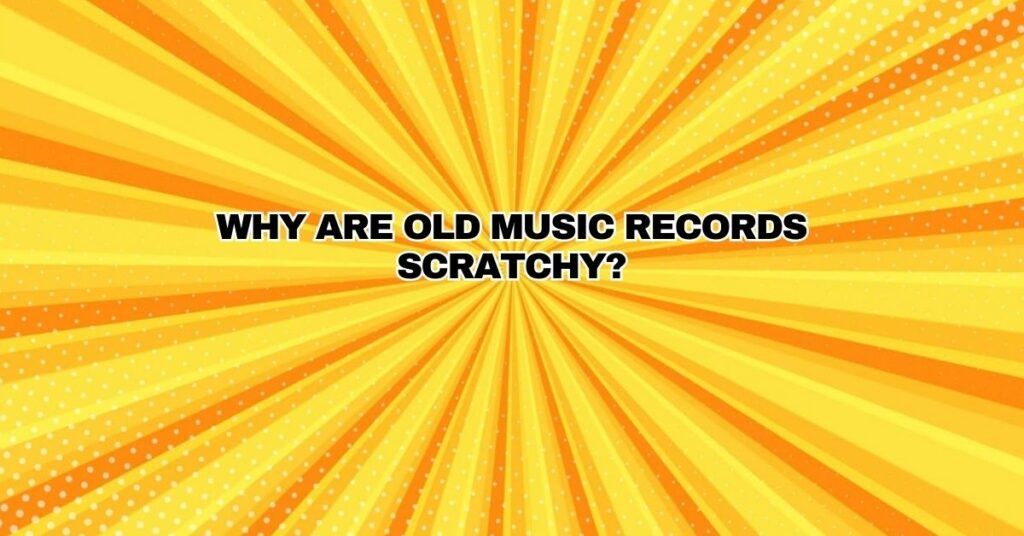The allure of vintage vinyl records is undeniable, offering a unique listening experience that bridges the gap between nostalgia and exceptional sound quality. However, if you’ve ever played an old music record, you’ve likely encountered that distinct, crackling sound in the background. This is a common phenomenon among vintage vinyl records, and it’s often referred to as “scratchiness.” But why are old music records scratchy, and what causes this distinctive noise? In this article, we will explore the fascinating science behind the scratchy sound in vintage vinyl records and what factors contribute to it.
The Anatomy of a Vinyl Record
To understand why old vinyl records can be scratchy, it’s essential to grasp the fundamental components of a vinyl record and how it produces sound.
- Grooves: Vinyl records contain grooves, which are spiral patterns etched into the surface of the record. These grooves represent the audio information in the form of variations in depth and width.
- Stylus and Cartridge: A turntable’s stylus (needle) is a tiny, sharp-tipped component that tracks the grooves on the record. It is attached to a cartridge, which converts the mechanical motion of the stylus into electrical signals.
- Amplification: The electrical signals generated by the cartridge are then amplified and sent to a speaker or headphones, where they are converted back into sound waves.
Why Are Old Music Records Scratchy?
- Wear and Tear: One of the most significant reasons for the scratchy sound in old records is wear and tear. As a stylus moves through the grooves, it experiences friction and pressure. Over time, this physical contact with the vinyl material can result in the formation of tiny imperfections and even the removal of small particles from the surface. These imperfections cause noise when the stylus travels over them, resulting in the characteristic crackling sound.
- Dust and Debris: Dust and debris that accumulate on the surface of a record can exacerbate scratchiness. Even the tiniest particles can affect the interaction between the stylus and the grooves, leading to additional noise during playback.
- Imperfections in the Vinyl: During the manufacturing process, vinyl records may develop imperfections or irregularities, such as tiny pits or bumps. When the stylus encounters these imperfections, they can produce noise in the playback.
- Vinyl Deterioration: Vinyl material is prone to deterioration over time. Factors like exposure to heat, humidity, and sunlight can contribute to the breakdown of the vinyl compound. This deterioration can cause records to become more scratchy as they age.
- Oxidation and Molding: In some cases, vinyl records can develop mold or mildew, leading to surface irregularities that affect playback. Oxidation, which can occur when records are stored improperly, can also contribute to surface degradation and scratchiness.
- Static Electricity: Static electricity can attract dust and debris to the surface of a record, further exacerbating the scratchy sound. Anti-static cleaning methods and products can help mitigate this issue.
Reducing Scratchiness and Improving Playback
If you have a collection of old vinyl records and want to improve playback quality, consider the following tips:
- Cleaning: Regularly clean your records using specialized record cleaning brushes, solutions, or cleaning machines to remove dust and debris. Clean records are less likely to produce scratchy sounds.
- Proper Storage: Store your records vertically in a cool, dry, and dark environment. Use anti-static sleeves and inner sleeves to protect the surface from dust and static.
- Upgrade Equipment: Invest in a high-quality turntable, stylus, and cartridge. Modern turntables with advanced features can provide a smoother playback experience.
- Digital Restoration: Some software programs and devices offer the capability to digitally restore old vinyl recordings by reducing noise and crackling.
Conclusion
The distinctive scratchy sound of old music records is a result of various factors, including wear and tear, dust, vinyl imperfections, and the natural aging of the material. While scratchiness may be an inherent characteristic of vintage vinyl, it can be mitigated to some extent through proper maintenance, cleaning, and playback equipment. The charm of old records lies not only in their sound but in the nostalgia they evoke, making the occasional crackling and pop a small price to pay for the unique and authentic music experience they provide.


